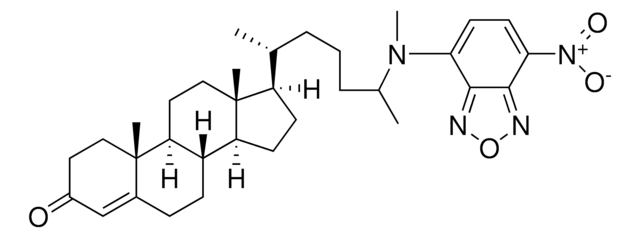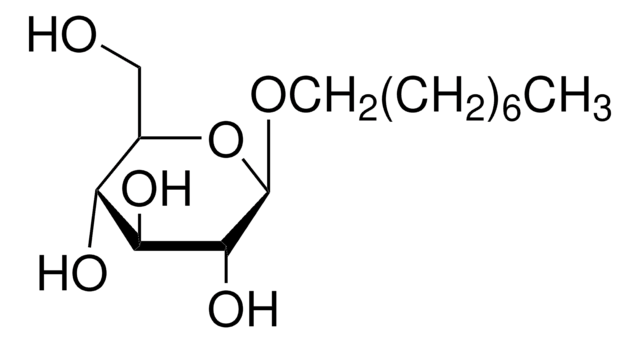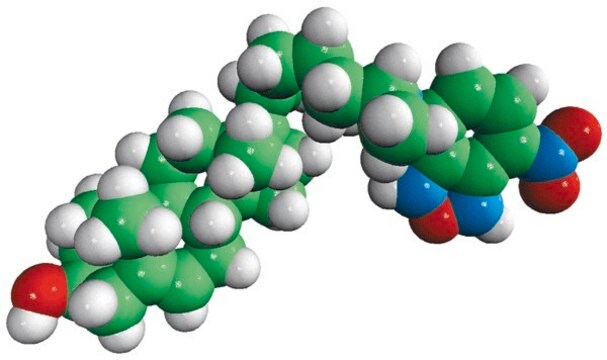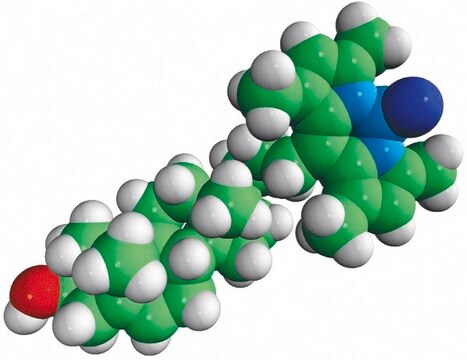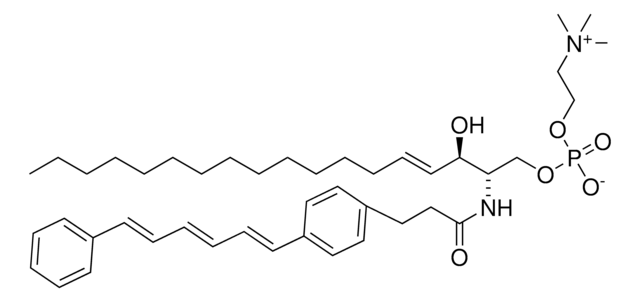810227P
Avanti
C12-NBD Lactosyl Ceramide
Avanti Research™ - A Croda Brand 810227P, powder
Synonym(s):
N-[12-[(7-nitro-2-1,3-benzoxadiazol-4-yl)amino]dodecanoyl]-D-lactosyl-β1-1′-sphingosine
Sign Into View Organizational & Contract Pricing
All Photos(1)
About This Item
Empirical Formula (Hill Notation):
C48H81N5O16
CAS Number:
Molecular Weight:
984.18
UNSPSC Code:
12352211
NACRES:
NA.25
Recommended Products
Assay
>99% (TLC)
form
powder
packaging
pkg of 1 × 50 μg (810227P-50ug)
manufacturer/tradename
Avanti Research™ - A Croda Brand 810227P
shipped in
dry ice
storage temp.
−20°C
General description
C12-NBD Lactosyl ceramide is a fluorescent analog of biologically available compound lactosyl ceramide. Lactosyl ceramideis generally present on neutrophils and macrophages.
Biochem/physiol Actions
Lactosyl ceramide is the major precursor for synthesis of various glycosphingolipids like oligoglycosylceramides and gangliosides. It is an important signaling molecule that is involved in adhesion, migration, cell proliferation and angiogenesis. Lactosyl ceramide is vital for osteoclastogenesis mediated by macrophage-colony stimulating factor.
Packaging
5 mL Amber Glass Screw Cap Vial (810227P-50ug)
Legal Information
Avanti Research is a trademark of Avanti Polar Lipids, LLC
Storage Class Code
11 - Combustible Solids
WGK
WGK 3
Flash Point(F)
Not applicable
Flash Point(C)
Not applicable
Choose from one of the most recent versions:
Certificates of Analysis (COA)
Lot/Batch Number
Sorry, we don't have COAs for this product available online at this time.
If you need assistance, please contact Customer Support.
Already Own This Product?
Find documentation for the products that you have recently purchased in the Document Library.
T Iwamoto et al.
The Journal of biological chemistry, 276(49), 46031-46038 (2001-10-11)
Glycosphingolipids and their metabolites play important roles in a variety of biological processes. Several signal molecules are localized in a glycolipid-enriched microdomain on the cell surface, and their signals are regulated by the glycolipid composition. However, the function of glycolipids
W I Weis et al.
Annual review of biochemistry, 65, 441-473 (1996-01-01)
Lectins are responsible for cell surface sugar recognition in bacteria, animals, and plants. Examples include bacterial toxins; animal receptors that mediate cell-cell interactions, uptake of glycoconjugates, and pathogen neutralization; and plant toxins and mitogens. The structural basis for selective sugar
S Hakomori et al.
Journal of biochemistry, 118(6), 1091-1103 (1995-12-01)
Glycosphingolipids (GSLs), cell type-specific markers which change dramatically during ontogenesis and oncogenesis, have been implicated as playing major roles in cellular interactions and control of cell proliferation in multicellular organisms. These functional roles have been partially clarified through two types
Our team of scientists has experience in all areas of research including Life Science, Material Science, Chemical Synthesis, Chromatography, Analytical and many others.
Contact Technical Service
